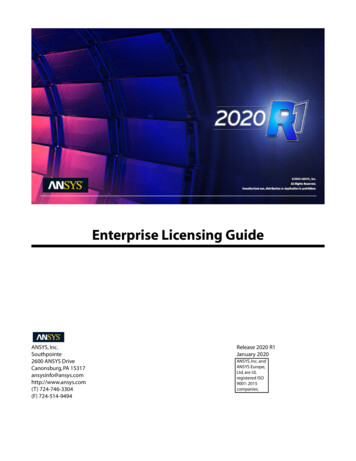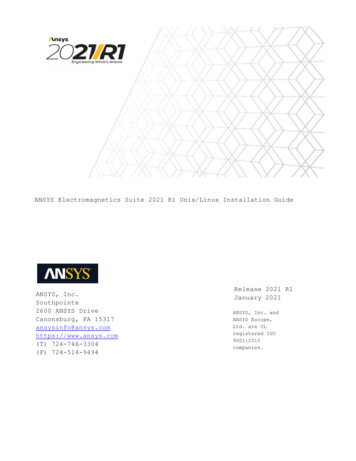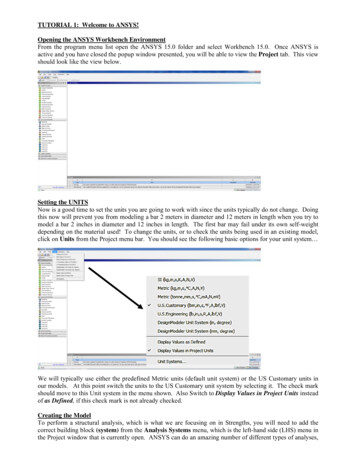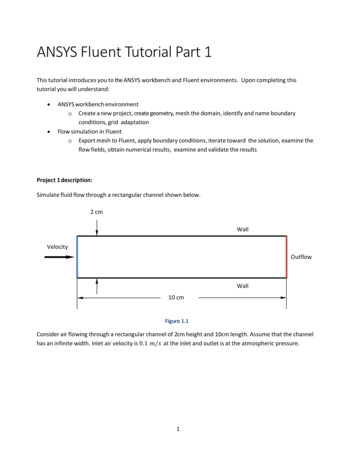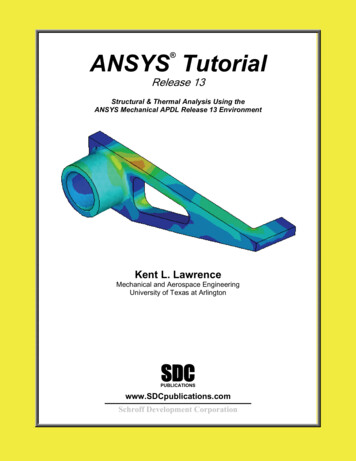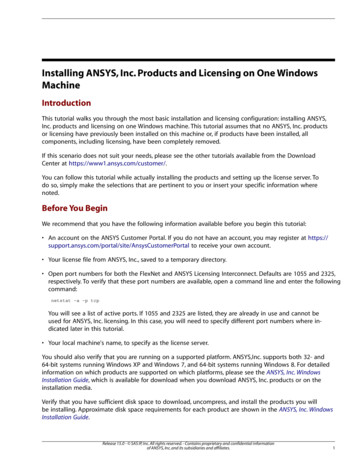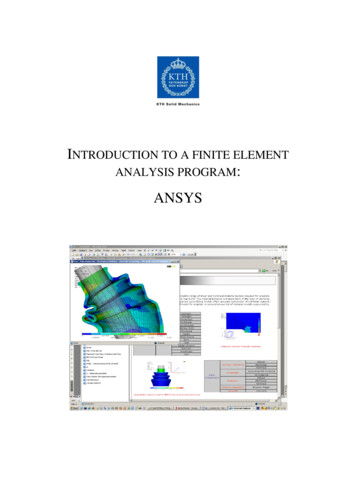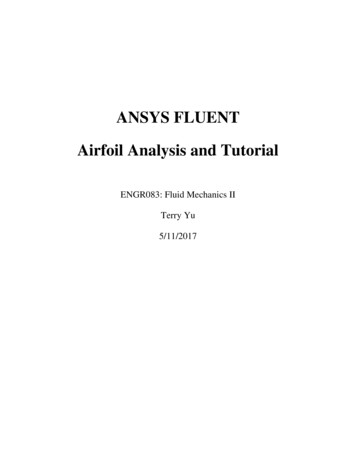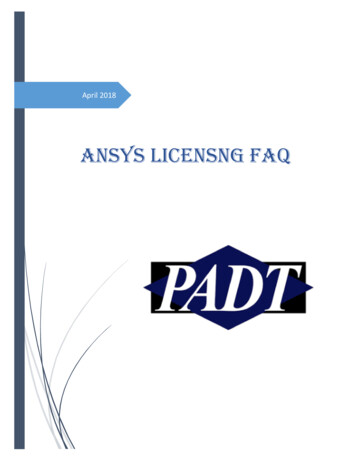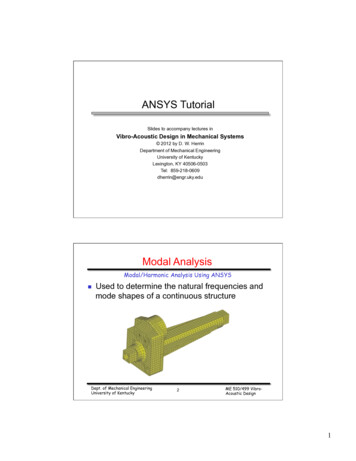
Transcription
ANSYS TutorialSlides to accompany lectures inVibro-Acoustic Design in Mechanical Systems 2012 by D. W. HerrinDepartment of Mechanical EngineeringUniversity of KentuckyLexington, KY 40506-0503Tel: 859-218-0609dherrin@engr.uky.eduModal AnalysisModal/Harmonic Analysis Using ANSYSgUsed to determine the natural frequencies andmode shapes of a continuous structureDept. of Mechanical EngineeringUniversity of Kentucky2ME 510/499 VibroAcoustic Design1
Review of Multi DOF SystemsModal/Harmonic Analysis Using ANSYSx1K1F1K2M1C1gx2F2K3M2C2C3Expressed in matrix form as[M ]{u } [C]{u } [K ]{u} {F}Dept. of Mechanical EngineeringUniversity of Kentucky3ME 510/499 VibroAcoustic DesignReview of Multi DOF SystemsModal/Harmonic Analysis Using ANSYS[M ]{u } [C]{u } [K ]{u} {F}ggThe mass, damping and stiffness matrices areconstant with timeThe unknown nodal displacements vary withtimeDept. of Mechanical EngineeringUniversity of Kentucky4ME 510/499 VibroAcoustic Design2
Modal AnalysisModal/Harmonic Analysis Using ANSYSggggA continuous structure has an infinite number ofdegrees of freedomThe finite element method approximates thereal structure with a finite number of DOFsN mode shapes can be found for a FEM havingN DOFsModal Analysisü Process for determining the N natural frequencies andmode shapesDept. of Mechanical EngineeringUniversity of Kentucky5ME 510/499 VibroAcoustic DesignModal AnalysisModal/Harmonic Analysis Using ANSYSggGiven “suitable” initial conditions, the structurewill vibrateü at one of its natural frequenciesü the shape of the vibration will be a scalarmultiple of a mode shapeGiven “arbitrary” initial conditions, the resultingvibration will be aü Superposition of mode shapesDept. of Mechanical EngineeringUniversity of Kentucky6ME 510/499 VibroAcoustic Design3
Modal AnalysisModal/Harmonic Analysis Using ANSYSggDetermines the vibration characteristics (naturalfrequencies and mode shapes) of a structuralcomponentsNatural frequencies and mode shapes are astarting point for a transient or harmonicanalysisü If using the mode superposition methodDept. of Mechanical EngineeringUniversity of Kentucky7ME 510/499 VibroAcoustic DesignMode Shape of a Thin Plate (240 Hz)Modal/Harmonic Analysis Using ANSYSDept. of Mechanical EngineeringUniversity of Kentucky8ME 510/499 VibroAcoustic Design4
Mode Extraction MethodsModal/Harmonic Analysis Using ANSYSgSubspacegBlock LanczosgPowerDynamicsgReducedgUnsymmetricgDamped and QR damped (Include damping)Dept. of Mechanical EngineeringUniversity of Kentucky9ME 510/499 VibroAcoustic DesignSteps in Modal AnalysisModal/Harmonic Analysis Using ANSYSgggBuild the modelü Same as for static analysisü Use top-down or bottom-up techniquesApply loads and obtain solutionü Only valid loads are zero-value displacementconstraintsü Other loads can be specified but are ignoredExpand the modes and review resultsDept. of Mechanical EngineeringUniversity of Kentucky10ME 510/499 VibroAcoustic Design5
In-Class ExerciseModal/Harmonic Analysis Using ANSYSE 30E6 psib 43 inh 5 in2 lb s ρ 8.031E 4 3 in in 360 inchesDept. of Mechanical EngineeringUniversity of Kentucky11ME 510/499 VibroAcoustic DesignIn-Class ExerciseModal/Harmonic Analysis Using ANSYSgggSet element type to BEAM188Set the appropriate material constants andsection propertiesCreate Keypoints at the start and end of thebeam and a Line between themDept. of Mechanical EngineeringUniversity of Kentucky12ME 510/499 VibroAcoustic Design6
Create Three KeypointsModal/Harmonic Analysis Using ANSYSPreprocessor Modeling - Create Keypoints InActive CSg Enter the following values for keypoint 1 NPT 1, x 0, y 0 z 0 Apply Enter the following values for keypoint 2 NPT 2, x 180, y 0 z 0 Apply Enter the following values for keypoint 3 NPT 3, x 360, y 0 z 0 Apply Okay Dept. of Mechanical EngineeringUniversity of KentuckyME 510/499 VibroAcoustic DesignCreate Lines Between KeypointsModal/Harmonic Analysis Using ANSYSPreprocessor Modeling - Create Lines Straight Lineg Select KP 1 and 2 in graphics window Select KP 2 and 3 in graphics window Okay Dept. of Mechanical EngineeringUniversity of KentuckyME 510/499 VibroAcoustic Design7
Mesh the Lines to Create ElementsModal/Harmonic Analysis Using ANSYSPreprocessor Meshing - Size Controls Lines All Lines gg Size 5 Okay Preprocessor Meshing - Mesh Lines Pick All Okay Dept. of Mechanical EngineeringUniversity of KentuckyME 510/499 VibroAcoustic DesignMesh the Line and Apply B.C.sModal/Harmonic Analysis Using ANSYSgFix the Keypoint at the right end of the beamDept. of Mechanical EngineeringUniversity of Kentucky16ME 510/499 VibroAcoustic Design8
Set Solution OptionsModal/Harmonic Analysis Using ANSYSggChange the analysis type to Modalü Solution Analysis Type New Analysisü Modal Set the analysis optionsü Solution Analysis Optionsü Extract 10 mode OK ü Enter 1500 for the ending frequencyDept. of Mechanical EngineeringUniversity of Kentucky17ME 510/499 VibroAcoustic DesignSet Solution OptionsModal/Harmonic Analysis Using ANSYSgAt this point, you have told ANSYS to find aparticular quantity of modes and to look within aparticular frequency range. If ANSYS finds thatquantity before it finishes the frequency range,it will stop the search. If ANSYS does not findthat quantity before finishing the frequencyrange, then it will stop the search.Dept. of Mechanical EngineeringUniversity of Kentucky18ME 510/499 VibroAcoustic Design9
Set Solution OptionsModal/Harmonic Analysis Using ANSYSggSolve the load setANSYS generates a substep result for eachnatural frequency and mode shapeDept. of Mechanical EngineeringUniversity of Kentucky19ME 510/499 VibroAcoustic DesignPostprocessingModal/Harmonic Analysis Using ANSYSgList results summaryü gGeneral Postproc List Results ResultsSummaryRead results for a substepü General Postproc Read Results First Setü Plot deformed geometryü General Postproc Read Results Next Setü Plot deformed geometryDept. of Mechanical EngineeringUniversity of Kentucky20ME 510/499 VibroAcoustic Design10
Harmonic Response AnalysisModal/Harmonic Analysis Using ANSYSSolves the time-dependent equations of motionfor linear structures undergoing steady-statevibrationgAll loads and displacements vary sinusoidally atthe same frequencygFi F sin(ωt φ1 )Fj F sin(ωt φ2 )Dept. of Mechanical EngineeringUniversity of Kentucky21ME 510/499 VibroAcoustic DesignHarmonic Response AnalysisModal/Harmonic Analysis Using ANSYSAnalyses can generate plots of displacementamplitudes at given points in the structure as afunction of forcing frequencygDept. of Mechanical EngineeringUniversity of Kentucky22ME 510/499 VibroAcoustic Design11
Forced ResponseModal/Harmonic Analysis Using ANSYSgApply a 1.0 N load at the left end of the beamgNew Analysis HarmonicgSet the Analysis Optionsü Set the solution method to “Mode Superposition”Set the DOF printout format to “Amplitude andphase” OK ü ü Set the number of modes to 10 OK Dept. of Mechanical EngineeringUniversity of Kentucky23ME 510/499 VibroAcoustic DesignForced ResponseModal/Harmonic Analysis Using ANSYSgSet the frequency substepsSolution Load Step Opts – Time Frequency Freq and Substepsü Set the Harmonic Frequency Range tobetween 0 and 50 Hzü ü Set the number of substeps to 100ü Set to SteppedDept. of Mechanical EngineeringUniversity of Kentucky24ME 510/499 VibroAcoustic Design12
Forced ResponseModal/Harmonic Analysis Using ANSYSgSet the dampingSolution Load Step Opts – Time Frequency Dampingü ü gSet the Constant Damping Ratio to 0.01Solve the modelDept. of Mechanical EngineeringUniversity of Kentucky25ME 510/499 VibroAcoustic DesignExpansion PassModal/Harmonic Analysis Using ANSYSFinishSolution Analysis Type Expansion Pass Dept. of Mechanical EngineeringUniversity of Kentucky26ME 510/499 VibroAcoustic Design13
Expansion Pass SetupModal/Harmonic Analysis Using ANSYSSolution Load Step Opts Expansion Pass Single Expand Range of Solu’s100Important – if yes the files are huge50Solution Solve Current LSDept. of Mechanical EngineeringUniversity of Kentucky27ME 510/499 VibroAcoustic DesignForced ResponseModal/Harmonic Analysis Using ANSYSgEnter time history postprocessor Define Variables Define NewVariablesGraphVariablesList Variables andprint out to fileDept. of Mechanical EngineeringUniversity of Kentucky28ME 510/499 VibroAcoustic Design14
Create NodesModal/Harmonic Analysis Using ANSYSPreprocessor Modeling - Create Nodes In ActiveCSg Enter the following values for Node 1 NPT 1, x 180, y -10 z 0 Apply Dept. of Mechanical EngineeringUniversity of KentuckyME 510/499 VibroAcoustic DesignAdd Vertical Truss MemberModal/Harmonic Analysis Using ANSYSggPreprocessor Element type Add/Edit/Delete Add Okay Select Link 180 Close Preprocessor Real Constants Add/Edit/Delete Add Okay to select type 1 Enter the values A 10 in2 Okay Dept. of Mechanical EngineeringUniversity of Kentucky30ME 510/499 VibroAcoustic Design15
Set Element AttributesModal/Harmonic Analysis Using ANSYSgModeling Create Elements Elem Attributes Select appropriate material properties and real constant tablePreprocessor Modeling - Create Elements Auto-Numbered-ThruNodesg Select appropriate nodes and applyDept. of Mechanical EngineeringUniversity of Kentucky31ME 510/499 VibroAcoustic Design16
Modal/Harmonic Analysis Using ANSYS ME 510/499 Vibro-Acoustic Design Dept. of Mechanical Engineering University of Kentucky Set Solution Options g At this point, you have told ANSYS to find a particular quantity of modes and to look within a particular frequency range. If ANSYS fi
